Raised garden beds provide an easy solution when gardening at home, no matter what kind of space you’re working in
If you have a shovel and some soil, you can essentially dig and plant anything anywhere. But given the option, raised garden beds will make the job easier and could give you a better success rate for growing hearty herbs, vegetables, and flowers at home.
The biggest benefit to using raised garden beds in your yard at home versus the traditional method of digging and planting directly into the ground lies in the soil.
No matter what type of soil you’re starting with — bagged soil or native soil — you can easily make the soil better using a raised garden bed. After all, the two most important things to gardening success are great soil structure and drainage. And you can easily achieve optimal conditions for both soil and drainage using raised garden beds.
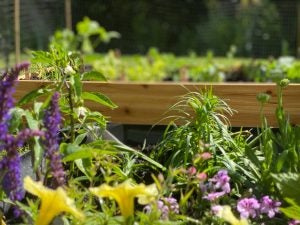
“If you have sandy or rocky soil, adding your own soil in a raised bed can bypass the challenges that come with trying to improve ground soil and digging in hard ground,” said Master Gardener Cassandra Rideg.
“With a raised bed, you have full control over what soil you’re putting in, so there’s no guessing or experimenting involved,” she said.
Having better soil structure is just one reason why raised beds are so effective for at-home gardeners. There are many situations where using a raised garden bed is ideal. Raised beds for gardening have a handful of additional benefits.
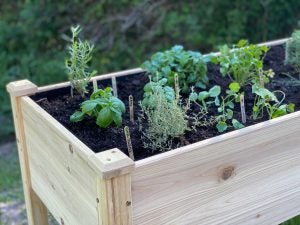
Choosing a raised garden bed
You can choose from a variety of raised garden beds both in stores and online. First, you’ll want to consider what size raised bed is best for you.
The bed should be wide enough so that the roots can spread out as much as they need to. But the bed shouldn’t be too wide, so you can reach every part of the bed without putting pressure on the soil or standing in it. Putting pressure on the soil can reduce aeration (the introduction of air into a material) and slow the activity of valuable microorganisms beneath the soil surface to help your plants thrive.
A good rule of thumb is to choose a raised bed that’s between 2 and 4 feet wide so you can reach in to maintain your plants from either side and never have to put pressure on the soil. The length of the bed and height is up to you, though 8 to 12 inches of soil depth is adequate for most gardeners. Consider how the bed will look in your garden space, what height is ideal for you physically to access, what you want to plant and your overall project budget.
If you have limited space or your time is limited, you may want to start out with just one raised bed. If you’re trying to produce a lot of your own fresh vegetables, it’s best to have at least two or three raised beds.
Here are three raised garden bed recommendations that I tested first-hand and are affordable, and I came away very happy with:

1. Best Choice Products Elevated Raised Wood Planter
A higher raised bed with legs like the Best Choice Products 48″x24″x30″ elevated raised wood planter garden bed box stand is a great choice if you’re looking for an ergonomic height. This bed is 30-inches tall — designed to use with no bending or kneeling to preserve your back and knees while you tend to your garden. Its all-wood construction is also made of fir wood that’s water and weather resistant, so you won’t have to worry about the structure sagging or warping over time.
“This type of raised bed is ideal for older gardeners and people with limited mobility,” said Rideg. “It’s also a good option for use on a porch or patio as you can easily access it right outside your door.”
This raised bed is also deep enough to ensure that your plants can breathe and grow healthy. And it comes with a liner that’s custom cut to fit the bed. The holes on the bed bottom paired with the included liner allows excess water to drain out — keeping your soil fresh and preventing rot and/or mineral build up.
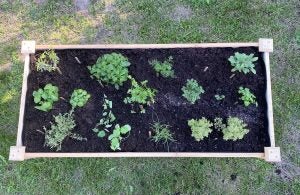
Specifications:
- Overall Dimensions: 48.5″(L) x 23″(W) x 30″(H)
- Garden Bed Planter: 47.5″(L) x 21.5″(W) x 8.75″(H)
- Weight: 34 lbs.
- Material: Fir Wood
- Weight Capacity: 200 lbs.
- Includes: Garden Bed Liner
- Assembly required
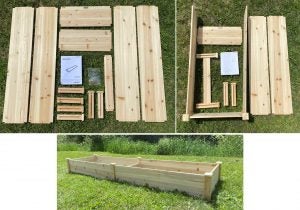
2. Costway Wooden Vegetable Raised Garden Bed
Another good wooden raised bed option is the Costway wooden vegetable raised garden bed. If you’re looking for a lot of space for growing your vegetables and flowers, this bed is ideal. Since it’s 8 feet long and 2 feet wide and sits directly on the ground, you’ll have enough room for two rows of plants on each side. It’s made of fir wood that’s built to last throughout the changing seasons.
You can put this bed anywhere in your backyard with a flat surface, like your patio, deck, lawn or porch. It’s also decorative and adds a nice aesthetic to any yard.
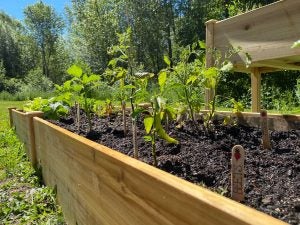
Specifications:
- Material: fir wood
- Thickness of board: 0.5″
- Dimensions: 97” x 25” x 10” (each box dimension: 48″x24″x10″)
- Product weight: 21.56 lbs.
- Assembly required
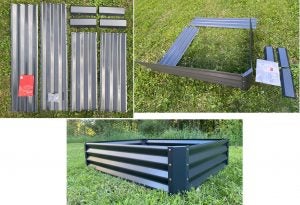
3. Best Choice Products Outdoor Metal Raised Garden Bed
The Best Choice Products 4’x3’x1′ outdoor metal raised garden bed is a bulletproof addition to any garden. With a bottomless base, water can flow through the soil to prevent water build up and plant roots can go deeper into the ground to access even more nutrients.
The galvanized steel structure has a rust-resistant finish and a nice look to it, so you’ll have a nice polished raised bed for many years. The width (at 3 feet) is also ideal for having several rows of flowers, vegetables, herbs, succulents, and more.
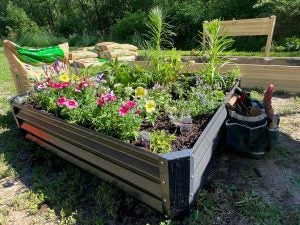
Specifications:
- Dimensions: 48”x36”x 12”
- Weight: 11.2 lbs.
- Material: Steel
- Assembly required
7 benefits to using raised garden beds
Raised garden beds are ideal for people who live in both urban and rural areas. A raised bed is optimal and makes gardening accessible. In addition to your backyard, you can build a raised bed on a porch, deck, patio, and even a rooftop — allowing you to garden anywhere outdoors without restrictions other than needing sunlight.
1. Quicker and easier than planting in ground soil
You can build one of the raised beds mentioned above in under an hour with just one person. And if you use an electric drill and have two people, that assembly time is a mere 20 minutes.
“If planned out right, you could be set up and planted on the same day,” said Rideg, the Master Gardener. “Soil in raised beds will warm up quicker than ground soil so it’s practically ready to use immediately.”
2. No digging involved — ideal for hard and rocky soil
If you’ve ever tried to dig in rocky or hard soil, you know it can be a challenge and time consuming — requiring sharp tools and often motorized or electric equipment to get the job done right.
“Soil composition doesn’t matter since you’re using brought in soil,” said Rideg, who recommends using an organic soil specifically designed for raised beds to give your plants all the nutrients they need, so you can just add water.
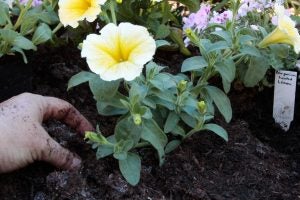
3. Makes crop rotation easier
When you use several raised beds, you can easily rotate your crops each year.
“Tomatoes, for example, should be rotated to a different box at least every other year” added Rideg. “This allows tomato diseases that can live in the soil to die off before you plant a tomato in the same spot.”
4. Easier to affix arches, trellises, covers and fencing
If you’re planting anything that needs extra support like cherry tomatoes or certain types of flowers, you’ll find it easy to add a trellis and/or arches. Having a raised bed also allows you to easily cover the beds (like during a frost) since you have sides to connect covers too.
“Raised beds are easier to add fences, too, for protection from animals like deer,” said Rideg, as you can attach poles directly up from the top of each corner of the boxes to wrap fencing around your garden.
5. Ease of weeding in less compact soil
Most likely, you’ll have minimal weed maintenance using raised beds.
“You’ll have minimal weeds in less compact soil,” said Rideg. When you’re planting directly into ground soil, weed maintenance can be time intensive. With raised beds, spending time de-weeding is nearly non-existent.
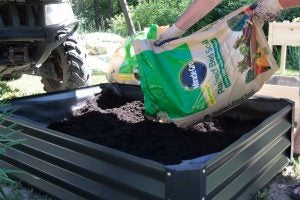
6. Easy to control soil composition
Since you’re adding your own soil, you choose what goes into a raised bed. You don’t have to guess what’s in your soil.
“It’s easier to amend your soil and fertilize,” said Rideg. “With a raised bed you can place additional soil and fertilizers exactly where you need them.”
7. Makes gardening accessible to more people
Since you can use a raised bed in both urban and rural areas in an area as small as a porch or patio, more people can have access to gardening. And when using elevated raised beds that are high enough to reach without bending, people with mobility issues can enjoy gardening.
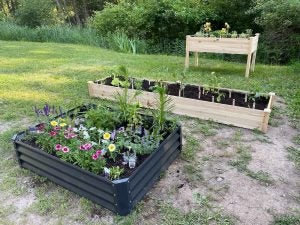
3 additional tips for using a raised bed
Choose a location with plenty of sunlight
For optimum plant health, most common outdoor plants and vegetables need at least 8 hours of full sunlight every day.
“The more sun the better,” Rideg said. “You’ll want to put your raised beds in the sunniest part of your yard, patio or deck.”
Make sure you have a nearby water source
You’ll also need access to water. Make sure you have a nearby hose or a portable watering can, so you can easily water your garden.
You’ll need to water every morning. “It’s best to water in the morning,” Rideg said. “If you water too late in the day the sun can overheat your plants and you risk water staying on your leaves which could produce mold and stunt the growth.”
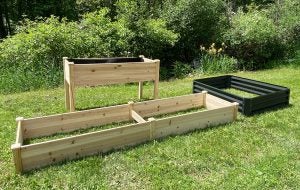
Have a plan before you plant
Before you fill your raised bed with anything, you should have a plan. Calculate how much soil you’ll need based on the cubic square feet of your box. Next, research which soil is best for you and your budget. Then, think about what you’d like to plant in your raised bed.
“Consider if you want to use seeds or plant starts,” Rideg said.
“Think about what your desires are, like the convenience of stepping out of your house to pick your own veggies and herbs. Do you want to grow flowers as a hobby? Do you want to grow vegetables to educate your children about sustainability? Or do you want to simply know where and how your food was grown for health reasons?”
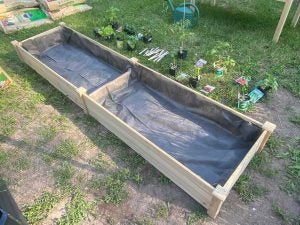
Once you know what you want to plant, you can start planning your garden.
One way to plan out your raised garden bed is to use a grid-planning method. For example, if you want to plant herbs in one box, think about what types of herbs you like. Then, grab a pen and paper, draw out a grid that corresponds with the size of your box and write down what you’d like to plant in each section of your box.
Having a solid plan before you begin the project will make your shopping and planting a breeze since you can lay out your herbs, plants or flowers on the ground in front of your raised bed ahead of time — making your planting fail proof.
“Remember to make sure you put higher growing plants in the back,” added Rideg, “so they won’t block the sun from your other lower growing plants.”
Planting plans for using raised garden beds
Here is an example of an herb garden plan:
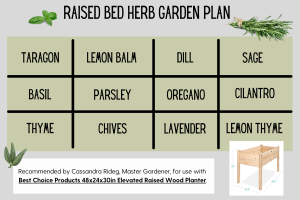
Here is an example of a vegetable garden plan:
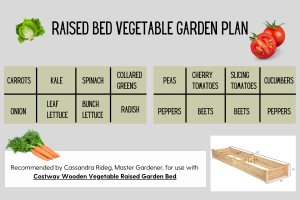
Here is an example of a flower garden plan (ideal to attract pollinators):
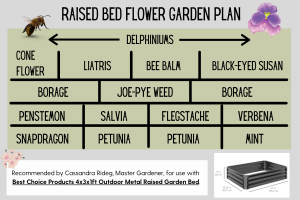
How big should a raised bed be?
An ideal raised garden bed is between 2 and 4 feet wide — that way you can maintain your plants from either side and never have to put pressure on the soil. The length of the bed depends on your garden/yard space and how you want it to look there. The height of a raised garden bed’s box is somewhat subjective, but 8 to 12 inches of soil depth is adequate for most gardeners and is the general recommendation from experts.
Should a raised garden bed be lined?
Many raised garden beds that you buy as part of a kit from a store will include a liner that’s custom sized to that project. (However, not all do that, like with the metal garden bed featured above.) Especially if they’re wooden, lined garden beds can be more durable and help keep a separation from the quality soil you choose for the bed and the native soil beneath it. A porous and breathable landscape fabric works well, and can even help keep unwanted insects and other pests out of your beds.
Editor’s recommendations
6 reasons you should garden for your health
Fruit or vegetable: Botany and kitchens may not agree
8 of the best garden tools for first-time gardeners
Master Gardener on mission to help cerebral palsy community
6 best pruning shears of 2021 for your gardens
Suzanne Downing is an outdoor writer and photographer in Montana with an environmental science journalism background. Her work can be found in Outdoors Unlimited, Bugle Magazine, Missoulian, Byline Magazine, Communique, MTPR online, UM Native News, National Wildlife Federation campaigns and more.
This article was published on behalf of Walmart.



